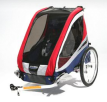Model-based architecture (MDA) or model-based development is an idea that to me comes from the automotive field. To, it means that you use some tool that is capable of modeling both a computer controller system and the environment being controlled to create a simulation world where computer control and environment meet and the characteristics of the controller can be ascertained quickly. The key is to not have to convert controller algorithms to concrete code, and not have to run concrete code on concrete hardware against physical prototypes to test the controllers. Today, this seems to be applied to many fields where you are creating control systems (automotive, aviation, robotics). The tools are math-based like MatLab and LabView, along with special programming environments based on UML and StateCharts.
What is interesting is that most of these tools are graphical in nature. And they do seem to work quite well, which is quite surprising given the otherwise poor record of graphical programming as opposed to text-based programming. There were a pile of graphical programming environments in the 1980’s, none of which amounted to much. What survived and prospered were the good old text-based languages like C, C++, Java, VisualBasic, etc. In practice, it seems like it is very hard to beat sequential text when it is time to actual get code working. More efficient programming seems to boil down to having to write less text and having text which is easier to write (for example, dynamic typing, rich libraries, garbage collection, and other modern language features that remove intellectual burdens from the programmer).
But graphics do seem to work for domain-specific cases (like control engineering or signal processing), especially for data-flow-style problems. And for abstract architecture work. So there has to be something to it… but what?
Continue reading “Schirrmeister has a nice observation on model-based development”
 I just read the panel interview at the start of the latest issue (Number 4, 2008) of ACM Queue. Here, you have Bryan Cantrill of Sun (the man behind dTrace) bemoan the difficulty of testing faults. In particular:
I just read the panel interview at the start of the latest issue (Number 4, 2008) of ACM Queue. Here, you have Bryan Cantrill of Sun (the man behind dTrace) bemoan the difficulty of testing faults. In particular:
 I just read an opinion-provoking piece
I just read an opinion-provoking piece  I just listened to another Floss Weekly show,
I just listened to another Floss Weekly show, 


 Last year, we got ourselves one of the best child-related products we have ever seen: a
Last year, we got ourselves one of the best child-related products we have ever seen: a  In the
In the